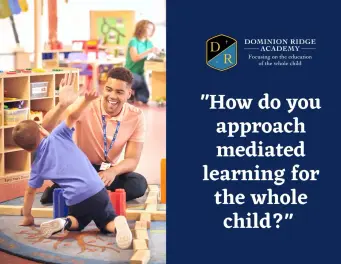
The Power of Mediated Learning: Advocating for Administrative Support of NILD
Educational Therapy Strategies
Key Programs
Written By: Lorraine Hewitt
November 19, 2021
As a life-long educator, I'm amazed - but not surprised - by the resilience and optimism of our students. When partnered with caring parents and talented teachers, these innate qualities result in a genuinely transformative grit. The challenge we now face in education is addressing how our schools equip our students to succeed when facing life's inevitable challenges. Like many administrators, I have sincerely questioned how to help students flourish in these unprecedented times. Many schools take students with vulnerabilities but feel uncertain about how to serve them. For me, the answers sprung from the science of neuroeducation.

Neuroeducation explores how children learn and what practices promote and sustain the learning process. In my role as the Superintendent of Dominion Ridge Academy, finding the right avenue to integrate neuroeducation into our approach was just the beginning of our journey. We quickly realized that we needed to help our school board fully understand what this meant for our students. Garnering support for this integration was possible because the effectiveness of mediated learning sells itself.
It is at this point that our story at Dominion Ridge intersects with NILD. We founded our school in 2006 from the desire to provide a non-denominational, classical school serving PreK through 12th grade, committed to its students' spiritual, moral, and intellectual formation. The vision for Dominion Ridge was to create a holistic approach to education whereby all children from vulnerable to gifted not only learn in the classrooms but also learn how to transfer that learning to their everyday life. Our big question to answer was how? My search shifted from modifying the curriculum to the discovery of modifiability. This transition of approach made all the difference in getting administrative buy-in because it centered on how we could integrate educational therapy into the fabric of our school. Some of our tenured staff can still recall me saying, "Curriculum is the tool, not the rule!" The problem was that we didn't fully understand our students. The solution? Teaching all to teach all.

The idea of "teaching all to teach all" begins with brain plasticity. Educators can leverage various cognitive tools and techniques designed to foster a child's innate learning potential by focusing on the whole child. My experience shows that nearly all students can become critical thinkers and competent learners with the proper support. After all, teaching children how to learn creates lifelong learners who can adapt to new situations. Indeed, last school year showed that adaptability is critical. While my generation likes to tell tongue-in-cheek tales about "walking miles in snowstorms to get to school," this generation walks mental miles in a different kind of storm. Administrators have tough decisions to make for their schools. The real question to answer is how we will approach mediating learning for the whole child?

With 730 active therapists in 35 states and 16 countries, over 4,000 trained educators, and a record of assisting more than 100,00 students, it is obvious why NILD is the recognized leader in educational therapy. Our long-standing relationship as an NILD-affiliated school progressed into becoming a Flagship School for NILD's Inside program. The program initially focused on students with learning challenges but broadened engagement to extend benefits to all students. Our entire staff went on to receive Feuerstein Instrumental Enrichment (FIE) training. These decisions ultimately supported our drive to ensure that all our students are understood and culminated in our Center for Cognitive Formation (CCF).
The success of CCF often leads to questions about how we garnered support for this integration. The first step is to identify who needs to support this decision for your school. For us, it was our Board. Next, we needed to reframe our "why" and define the problem. When the Board understood that NILD provided a framework for us to understand our students better, getting approval became more accessible. NILD became a vital part of our approach when we started trying to address how we were mediating the learning experience of the whole child. Their credibility, long-standing history, and lasting results provided further proof of the benefits of integrating NILD into the fabric of your school.

The result of this integration is that our learning is not just a tutorial but therapeutic. The framework centers around balancing not just social cognition but also emotional intelligence. The mediated learning experience is motivated by understanding the importance of the dignity of a child. When we can cultivate a child's confidence, competence, and belonging, they have room to grow into their full potential. Most importantly, when the Board understood that the product is a life and our interest is wholly about the child, the process of advocating for the correct integration of programs like NILDinside became vitally important to us. That is a benefit that I would hope any educational decision-maker would see as key to unlocking how we understand our students.

When your product is a life, then your interest always starts with the child. How then do we approach cultivating the best in your students? Do we know how to serve our students? When we understand the child, it informs how we craft the learning experience. Lives are changed when understanding, respecting, and nurturing the dignity of all learners is the primary goal.

Lorraine Hewitt, M.Ed., PCET
To contact Mrs. Hewitt, please email lhewitt@dominionridgek12.com or visit www.dominionridgeacademy.com.